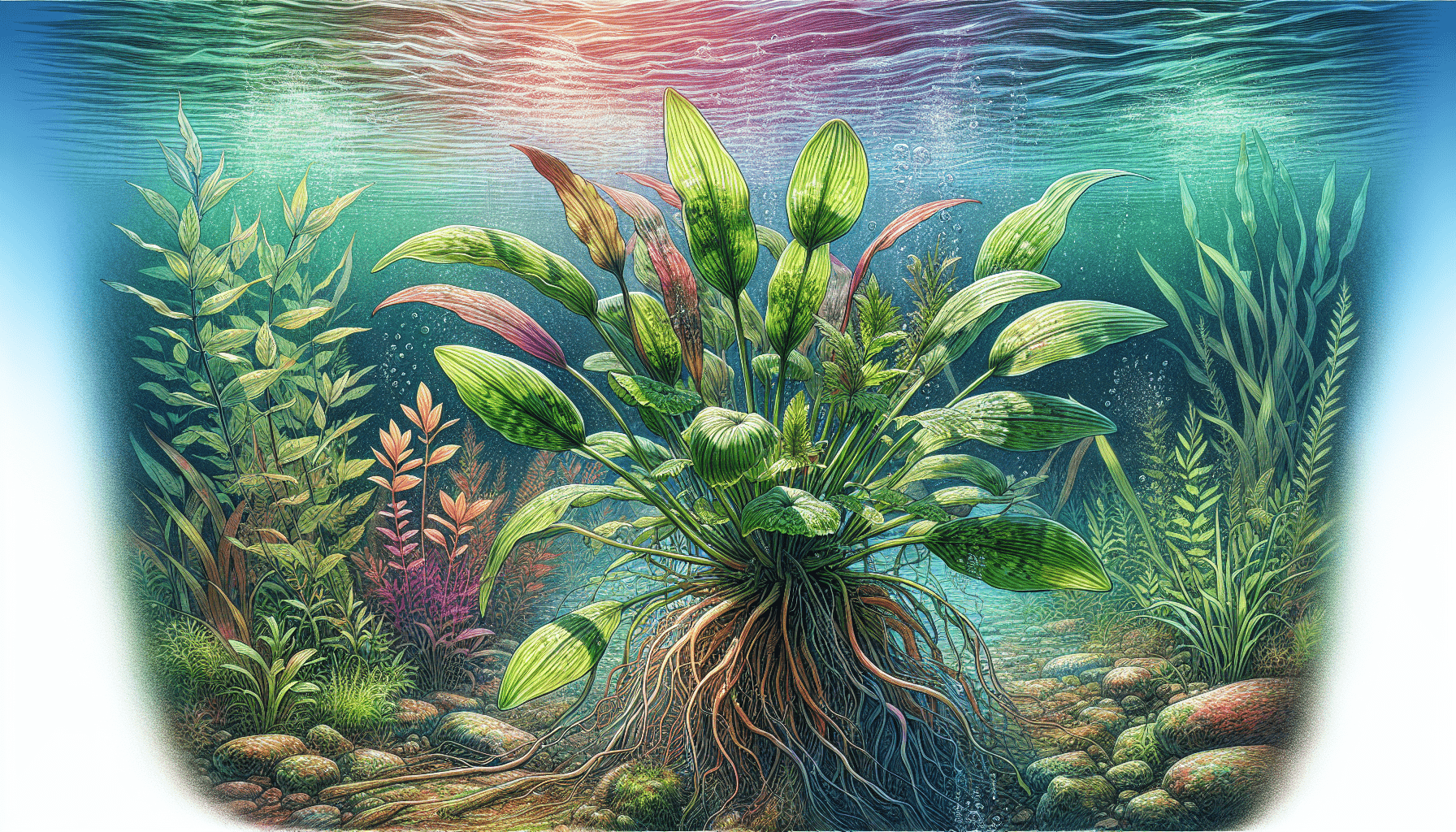As a botanist or eco enthusiast, you may have heard of Veronica Anagallis-aquatica, commonly known as the water speedwell. This scientific paper examines the salient characteristics, habitat, and potential ecological impacts of this particular aquatic plant. Diverse facets of Veronica Anagallis-aquatica will be systematically analyzed to provide you a comprehensive understanding of its nature and ecological significance. This paper explores not just the plant’s physical characteristics but also its propagation modes, preferred conditions, and implications for aquatic ecosystems, thus paving the way for a deeper comprehension of aquatic weeds and their interactions within our environments.

General Description of Veronica Anagallis-aquatica
Overview and origin
Veronica Anagallis-aquatica, commonly known as water speedwell or blue water-speedwell, is a species of flowering plant in the plantain family, Plantaginaceae. The species originated in the cooler regions of the Northern Hemisphere and was later naturalized in other parts of the world. It is known as both an annual and a perennial herb that is typically found in damp habitats.
Physical characteristics
You will find Veronica Anagallis-aquatica is characterized by its slender, quadrangular stem and opposite, ovate-oblong leaves. The leaves, which are toothed and have short petioles, taper at both ends. The plant semi-aquatic plant also sports small, bright blue or violet flowers that bloom from June to August. These flowers have four petals and are frequently found in axillary racemes or spikes.
Habitats and distribution
As an aquatic or semi-aquatic perennial, Veronica Anagallis-aquatica thrives in wet environments such as margins of ponds, streams, and ditches. It is found throughout Europe, North America, Asia, and parts of Africa. It is rather took to water, hence can adapt in a variety of aquatic habitats, from flowing fresh water to still, slightly brackish bodies of water.
Scientific Classification of Veronica Anagallis-aquatica
Kingdom and domain
Veronica Anagallis-aquatica belongs to the kingdom Plantae, which comprises all plants. Its domain is Eukarya, which includes organisms that have cells with nuclei.
Family and genus
This species is a member of the Plantaginaceae family, also known as the plantain family. It belongs to the Veronica genus, which includes about 500 species of flowering plants known for their speedwell characteristic.
Species name and its significance
The species name “Anagallis-aquatica” is derived from Greek. “Anagallis” means “laughing”, possibly a reference to the plant’s ability to thrive in wet conditions, and “aquatica” indicates its aquatic nature.
Growth Patterns of Veronica Anagallis-aquatica
Seasonal behavior
Veronica Anagallis-aquatica is described as a summer annual or short-lived perennial. The plant grows and blooms in the warm months, typically from June to August, and becomes dormant or dies back in colder seasons.
Conditions for optimal growth
It thrives in wet or moist habitats, preferring full light exposure. It is not particular about soil pH and can grow in neutral, alkaline, or acid soils. It is also adaptable to a broad range of temperatures, from mildly cool to warm climates.
Life cycle
The life cycle of the Veronica Anagallis-aquatica begins with seed germination that takes place in the early spring. After germination, the plant grows and develops its distinctive blue flowers in the summer, subsequently producing seeds.

Reproduction and Dispersal
Flower structure and pollination
Each flower of the Veronica Anagallis-aquatica has four petals and two stamens. The flowers are hermaphroditic, with both male and female organs, and are usually pollinated by bees and flies.
Seed production and dispersal process
The plant produces numerous seeds which fall close to the parent plant and can further be dispersed by water currents. It also reproduces asexually via facultative viviparity where developing embryos can take root while still attached to the maternal plant, a common feature in aquatic plants.
Regeneration capabilities
Veronica Anagallis-aquatica has a strong regenerative capability. Even when damaged, it can quickly reestablish from the remaining parts.
Ecological Role of Veronica Anagallis-aquatica
Role in aquatic ecosystems
In its native regions, Veronica Anagallis-aquatica contributes to the biodiversity of aquatic ecosystems. Its flowers attract pollinators, sustaining the local fauna, while its roots and leaves provide shelter and sustenance for various aquatic organisms.
Interactions with wildlife and aquatic creatures
Veronica Anagallis-aquatica serves as a food source for various insects and animals. The plant also provides coverage and spawning habitats for certain species of fish, thus contributing to the aquatic food web.
Impact on water quality
Veronica Anagallis-aquatica can affect water quality as its considerable growth may lead to increased nutrient levels and decreased oxygen levels in the water, which can adversely affect other aquatic life.
Veronica Anagallis-aquatica as an Invasive Species
Invasive nature and impact
Due to its fast growth and prolific seed production, Veronica Anagallis-aquatica is considered an invasive species in various regions outside of its native distribution. It can form dense colonies, outcompeting other aquatic plants and altering aquatic ecosystems.
Geographical areas affected
Some of the most significantly affected regions include parts of the United States and Australia. In these regions, Veronica Anagallis-aquatica is listed as a noxious and invasive weed, posing threats to native biodiversity.
Strategies for control and management
Mechanical removal, chemical control, and the introduction of competing vegetation are common strategies to control the spread of Veronica Anagallis-aquatica. Each method must be carefully chosen based on the specific conditions of the environment to prevent potential damage to native vegetation and wildlife.
Uses of Veronica Anagallis-aquatica
Uses in traditional medicine
Traditionally, Veronica Anagallis-aquatica was used in medicine for its purported healing properties. Its leaves were used as an external treatment for wounds, while its flowers were used to treat eye conditions.
Role in landscaping and water gardens
In its native habitats, Veronica Anagallis-aquatica is regarded as a decorative addition to water gardens because of its beautiful blue flowers and lush green foliage. However, its invasive potential must be considered before using it in non-native environments.
Potential for research
Despite its invasive nature, Veronica Anagallis-aquatica holds research potential, particularly in the realm of phytoremediation. The plant’s ability to colonize and survive in pollutant-heavy environments suggests it could possess applications in cleansing water bodies of pollutants.
Challenges Posed by Veronica Anagallis-aquatica
Impact on aquatic biodiversity
In invaded territories, Veronica Anagallis-aquatica can form dense mats that crowd out native species, threatening the region’s aquatic biodiversity. The infestation could lead to monotony in aquatic vegetation, which could subsequently impact the balance of local aquatic fauna.
Problems for water management and navigation
Dense infestations of Veronica Anagallis-aquatica can interfere with water management operations and impede aquatic transportation. This poses significant challenges for recreational use of water bodies, commercial navigation, and drainage systems.
Concerns for public health and safety
While not directly harmful to humans, a large spread of the plant can impact water quality, leading to negative implications on health. Moreover, it can potentially create breeding grounds for mosquitoes and other pests.
Controlling and Eradicating Veronica Anagallis-aquatica
Mechanical control methods
Mechanical management of Veronica Anagallis-aquatica involves physically removing the plant from the water body, either by hand or with the use of machinery. This method can be effective if applied in early stages of infestation when the plant density is low.
Chemical control methods
Chemical control involves the application of herbicides to kill existing plants and prevent new growth. However, this method should be used sparingly to avoid detrimental effects on non-target species and water quality.
Biological control methods
Biological control involves the use of natural Veronica Anagallis-aquatica predators to limit its spread. Potential biocontrol agents include specific insects or pathogens.
Case Studies of Veronica Anagallis-aquatica Management
Successful eradication initiatives
Successful management cases typically involve a combination of the mentioned strategies. Especially promising have been the initiatives where quick identification of the infestation led to early mechanical removal.
Lessons learned from failed attempts
However, failed attempts often highlight the resistant nature of Veronica Anagallis-aquatica and the necessity for ongoing monitoring and management. It also underlines the importance of prevention as a far more cost-effective solution than eradication.
Models for future management of aquatic weeds
The management of Veronica Anagallis-aquatica can light the way for future aquatic weed management. A key factor for success is community engagement: ensuring that the public is informed about the risks of spreading non-native species, and soliciting their aid in reporting new infestations.